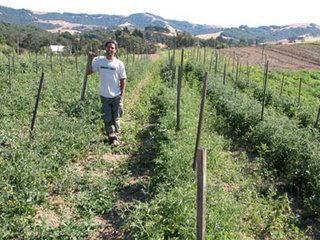
For those of us raised away from the farm, seasonality is an afterthought. Sure, the sweet corn is only around in summer. The apples are only local and fresh in the fall. Asparagus is only widely available and reasonably priced for a short stretch. Tomatoes are best in the summer, but around all year. But seasonality is not really an attribute of the produce section of the grocery store.
However, at the Farmers' Market, seasonality is a bitch. Not only do you have your favorite item of the moment disappearing almost as soon as it arrives, but you must tolerate the natural fluctuations of the farmer's cycle. The great basil of last summer from County Line Farm ended abruptly when "Dave decided to plow the rest of it under to get started on the fall crops." The broccoli rabe from Capay which was so wonderful two weeks ago when I made it at home for the first time ever, is non-existent.
The seasonality has its' upsides, too. In Northern California, I can eat locally all year long. So seasonal fluctuations really encourage me to change my eating habits throughout the year. Also, I have found that one gets very accustomed to absolute freshness. Last Fall, I was getting some apples from Paul, a Sebastopol-based grower, and asked, out of the blue, when this bunch was picked. He hesitated, then explained that this was an unusual week as the local paper was doing a story on him, he was extra-super busy, etc. Only then did he tell me that the apples were picked three days prior. Only
three days... and to him this was a
big deal. (Sunday's apples are usually picked on Saturday, I learned). While apples are certainly quite stable and tolerate storage well, freshness makes a discernable difference. This is, of course, only more pronounced in more delicate crops, which is basically everything else - minus potatoes and onions.
So today we welcomed back my favorite peach vendor, Kashiwase Farms. Sure, there were a couple of peaches around last week, but none that really attracted my attention. Kashiwase peaches are gorgeous. Their early varieties are certainly smaller than the later ones, but I came home with a few delicious-looking yellow peaches. Being surprised by their return to the market, as I was, is delightful, just as it is sad when they depart. But it is always good to see old friends again and welcome them back to the market and their produce back to my table.
Part of what makes a market special is the relationship I develop with a farmer or purveyour and their product. Seasonality only reinforces this. It also reminds us of the physical limitations upon which we are all ultimately dependant for our food.





